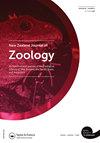在诺福克岛国家公园,牛油(Rhopalostylis baueri)在塔斯曼鹦鹉(Cyanoramphus cookii)饮食中的重要性
IF 1.1
4区 生物学
Q3 ZOOLOGY
引用次数: 0
摘要
摘要:塔斯曼长尾小鹦鹉的行为和饮食尚未得到定量描述。我们量化了该物种在秋冬季节的相对行为频率和食物多样性,以帮助完善该物种的当前管理。我们还收集了他们主要食物之一的可用性信息:niau(Rhopalostylis baueri)水果。以八种植物的果肉和种子为食的长尾鹦鹉。Niau水果占总进食次数的44%,表明这是秋冬季节的一种重要食物。在我们的观察中,最常见的行为状态是进食(30%的行为状态)。我们对塔斯曼长尾小鹦鹉发生的核心区域的鸟果可用性的估计表明,在春季结果高峰期,大约有120万个果实。塔斯曼长尾小鹦鹉是多面手,但鸟果是一种丰富而重要的资源。尽管鸟很常见,会产生大量的水果,但引入的老鼠(Rattus spp.)可能是塔斯曼长尾小鹦鹉的重要竞争对手,因为它们也以鸟的水果为食。因此,对老鼠的持续控制对于维持大量的本土水果以维持塔斯曼长尾小鹦鹉种群的增长至关重要。本文章由计算机程序翻译,如有差异,请以英文原文为准。
The importance of niau (Rhopalostylis baueri) in the diet of the Tasman parakeet (Cyanoramphus cookii) in the Norfolk Island National Park
ABSTRACT The behaviour and diet of the Tasman parakeet (Cyanoramphus cookii) have not been quantitively described. We quantified the relative frequency of behaviours and diversity of food items for the species during autumn and winter to help refine the current management of the species. We also collected information on the availability of one of their main foods: niau (Rhopalostylis baueri) fruits. Parakeets fed on fruit pulp and seeds of eight plant species. Niau fruits represented 44% of total feeding bouts indicating that this is an important food item during the autumn-winter period. The most common behavioural state during our observations was feeding (30% of behavioural states). Our estimate of niau fruit availability in the core area of Tasman parakeet occurrence indicates approximately 1.2 million fruits during the peak of fruiting in spring. Tasman parakeets are generalists, but niau fruits represent an abundant and important resource. Although niau are common and produce large quantities of fruit, introduced rats (Rattus spp.), potentially represent significant competitors to Tasman parakeets, because they also feed on niau fruits. Ongoing control of rats is thus critical to maintain large quantities of native fruits to sustain a growing population of Tasman parakeets.
求助全文
通过发布文献求助,成功后即可免费获取论文全文。
去求助
来源期刊
CiteScore
2.80
自引率
0.00%
发文量
20
审稿时长
>12 weeks
期刊介绍:
Aims: The diversity of the fauna of the southern continents and oceans is of worldwide interest to researchers in universities, museums, and other centres. The New Zealand Journal of Zoology plays an important role in disseminating information on field-based, experimental, and theoretical research on the zoology of the region.

 求助内容:
求助内容: 应助结果提醒方式:
应助结果提醒方式:


